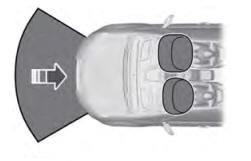Ford Explorer: Fuel and Refueling / Fuel Consumption
Advertised Capacity
The advertised capacity is the maximum amount of fuel that you can add to the fuel tank when the fuel gauge indicates empty. See Capacities and Specifications.
In addition, the fuel tank contains an empty reserve. The empty reserve is an unspecified amount of fuel that remains in the fuel tank when the fuel gauge indicates empty.
Note: The amount of fuel in the empty reserve varies and should not be relied upon to increase driving range.
Filling the Fuel Tank
For consistent results when refueling:
- Turn the ignition off before fueling; an inaccurate reading results if the engine is left running.
- Use the same fill rate (low-medium-high) each time the tank is filled.
- Allow no more than one automatic shut-off when refueling.
Results are most accurate when the filling method is consistent.
Calculating Fuel Economy
Your vehicle calculates fuel economy figures through the trip computer average fuel function. See Information Displays.
The first 1,000 mi (1,500 km) of driving is the break-in period of the engine. A more accurate measurement is obtained after 2,000 mi (3,000 km).
- Completely fill the fuel tank and record the initial odometer reading. See Refueling.
- Each time you fill the fuel tank, record the amount of fuel added.
- After at least three fill ups, fill the fuel tank and record the current odometer reading.
- Subtract your initial odometer reading from the current odometer reading.
To calculate L/100 km (liters per 100 kilometers) fuel consumption, multiply the liters used by 100, then divide by kilometers traveled. To calculate MPG (miles per gallon) fuel consumption, divide miles traveled by gallons used.
Keep a record for at least one month and record the type of driving, for example city or highway. This provides an accurate estimate of your vehicle’s fuel economy under current driving conditions. Keeping records during summer and winter shows how temperature impacts fuel economy.
Conditions
- Heavily loading your vehicle reduces fuel economy.
- Carrying unnecessary weight in your vehicle may reduce fuel economy.
- Avoid adding accessories that increase aerodynamic drag to your vehicle such as bug deflectors, car top carriers and ski or bike racks.
- Using fuel blended with alcohol may lower fuel economy.
- Fuel economy may decrease with lower temperatures.
- Fuel economy may decrease when driving short distances.
- You will get better fuel economy when driving on flat terrain than when driving on hilly terrain.
 Refueling - Hybrid Electric Vehicle (HEV)
Refueling - Hybrid Electric Vehicle (HEV)
WARNING: Do not overfill the fuel tank. The pressure in an overfilled tank
may cause leakage and lead to fuel spray and fire.
WARNING: Do not pry open the fuel tank filler valve...
Other information:
Ford Explorer 2020-2025 Service Manual: Description and Operation - Power Brake System - Overview
Electric Brake Boost Overview The power assisted brake system utilizes an EBB. The EBB is an integrated function of the ABS / HCU assembly and is controlled by the ABS module. The ABS/ HCU combines the functions of a conventional vacuum booster and ABS module...
Ford Explorer 2020-2025 Service Manual: Removal and Installation - Rear Door Upper Moulding
Removal NOTE: Removal steps in this procedure may contain installation details. NOTE: LH side shown, RH side similar. Remove the upper belt moulding screw at front of the door. Torque: 12 lb.in (1.3 Nm) Lift the moulding at the front edge using a non-marring trim tool and slide forward to disengage from the tab at the rear and remove th..
Categories
- Manuals Home
- 6th Generation Explorer Owners Manual
- 6th Generation Explorer Service Manual
- Body and Paint
- Description and Operation - Jacking and Lifting - Overview
- Description and Operation - Identification Codes
- New on site
- Most important about car
Driver and Passenger Airbags
WARNING: Do not place your arms on the airbag cover or through the steering wheel. Failure to follow this instruction could result in personal injury.
WARNING: Keep the areas in front of the airbags free from obstruction. Do not affix anything to or over the airbag covers. Objects could become projectiles during airbag deployment or in a sudden stop. Failure to follow this instruction could result in personal injury or death.
WARNING: Airbags can kill or injure a child in a child restraint. Never place a rear-facing child restraint in front of an active airbag. If you must use a forward-facing child restraint in the front seat, move the seat upon which the child restraint is installed all the way back.


